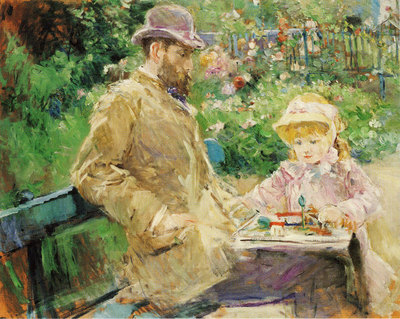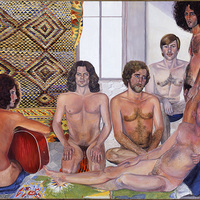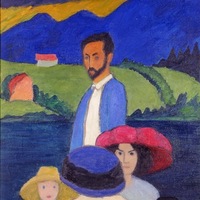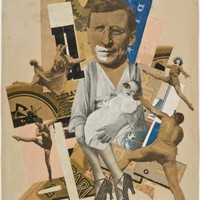Female Artists Showing Men
Interesting things happen when female artists begin putting their men on paper. Let us consider…
What do Hannah Höch, Sylvia Sleigh, Gabrielle Münter, and Berthe Morisot have in common? Each lived in different time periods in which the female stereotypes differed; but they all succeeded in one major accomplishment—portraying men in atypical roles.
Morisot’s Eugène Manet and his Daughter pushed the boundaries of acceptable subjects for female artists of the time. While she paints the usual flowers and child, she also paints her husband. In the 1880s, a man posing for a woman was unheard of, and Morisot went even further by portraying him playing with their daughter rather than working. Similarly, Höch’s The Father, (painted during her association with male Dadaists of the time), takes the male figure and places it in the typical female role—that of the nurturing mother caring for the children. The Turkish Bath, by Sylvia Sleigh also portrays men in atypical roles. Rather than showing her husband in a mothering role like Hoch and Morisot, Sleigh places her husband in the role of the nude model. Sleigh’s painting was a response to the 1970s idea of liberating sexuality, saying “I wanted to give my perspective, portraying both sexes with dignity and humanism (Smart Museum).” Sleigh accomplishes this by painting male art-figures, one of which was her husband, Lawrence Alloway. By having the men pose nude Sleigh was placing men in the role of the nude model, one typically occupied by females. Another well-known artwork by Höch, Da Dandy, blends gender roles. Höch uses cutouts of female bodies to piece together an image that forms the silhouette of a male head, leading us to wonder which gender is actually being portrayed. And last, but certainly not least, Münter paints her famous lover, Kandinsky. In her 1910 artwork, Boating, Münter and Kandinsky are shown in a boat, along with two other figures. However, rather than Kandinsky being shown in control and doing the work by pulling his weight, Münter shows him in the back, blankly staring into the distance while she does the work.
While the actual relationships between the female artists and the men they encountered were not always positive, what resulted were great artworks. Each in their own unique way, Hannah Höch, Sylvia Sleigh, Gabrielle Münter, and Berthe Morisot used their men as inspiration to create positive artwork.




